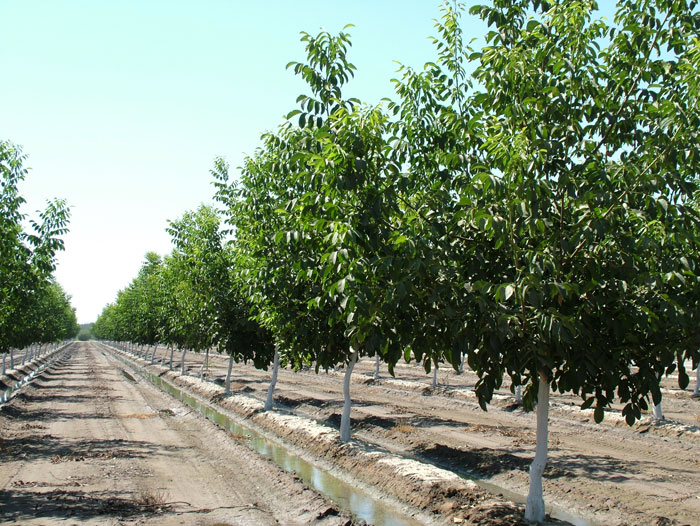July 20, 2016

As nut acreage continues to grow in California and as growers switch out of other crops into nuts, it’s nice to have a primer on going about that.
One exists, thanks largely to the efforts of Katherine Pope, University of California Cooperative Extension (UCCE) farm advisor for Sacramento, Solano, and Yolo counties, who developed a “Young Orchard Handbook” for almonds and walnuts.
Researchers agree that proper management of an orchard in its first five years of life is essential to optimizing orchard health, growth, and yield over the life of the orchard.
At a workshop on establishing new orchards, Pope said the handbook includes work sheets, for example, on irrigation scheduling.
“It’s not just theory,” she said. “This is what publication nerds call a living document,” she added, meaning its open to additions and changes.
She urged growers to let her know about suggested changes that might be in order. Pope said future versions are expected to include observations on pests, and Roger Baldwin, UC IPM statewide vertebrate control advisor, looking at vertebrate management for young orchards.
The handbook, along with a lot of additional information, can be found online at http://ceyolo.ucanr.edu/Fruit_and_Nuts/. Several video recordings of presentations on young orchard management are also available.
The handbook gives growers tools to make informed decisions about irrigation, fertilization, pruning and training, and weed management in young orchards.
“There is so much information scattered over the web these days that finding resources to care for a young orchard can be overwhelming,” Pope said.
This handbook pulls together a lot of the information in one place to give growers a solid grounding in the basics of early orchard management based on decades of UC research and experience.
Other authors include Allan Fulton and David Doll, UCCE farm advisors for Tehama and Merced Counties respectively, plus Bruce Lampinen, UCCE almond and walnut specialist, and Brad Hanson, UCCE weed specialist.
The development of the educational materials was supported in part by funding of local farm advisor projects from the Almond Board of California.
Bob Curtis, the board’s director of agricultural affairs, called the handbook “a wonderful example of the benefits of ongoing support to Extension programs and California almonds.”
In the handbook, Pope and Fulton wrote that proper irrigation management “may be one of the most complicated, dynamic aspects of young orchard management.” That’s because as trees grow, canopy size and water needs change, not just from year to year, but also within a season.
At the new orchard workshop, Blake Sanden, UCCE irrigation advisor at Kern County, said the key to proper soil moisture is to get water into the soil, make it uniform, get the right timing, and get the right amount. He pointed out that, due to the size of the root ball, first leaf trees may only access about 50 percent of the applied water.
Joe Connell, UCCE farm advisor Emeritus with Butte County, discussed pruning and training almond trees in the first five years to maximize production and minimize pruning costs. He said it is important to use tree wraps to keep herbicides off the bark of young trees and to keep rabbits and other critters at bay, plus protect the tree against sunburn.
Joe Grant, UCCE farm advisor with San Joaquin County, talked of the pros and cons of cover crops. He recommended Googling cover crops and calling upon seed dealers that specialize in them.
Advantages of cover crops can include improved water penetration, removal of excess water, allowing winter and spring access for machinery, curtailing runoff and erosion, weed and dust suppression, and providing habitat for beneficial insects.
On the down side, cover crops may use water that trees need, can increase the risk of frost, can become a habitat for nematodes and rodents, and may interfere with Navel orangeworm sanitation and pruning.
Dani Lightle, UCCE orchard systems advisor for Glenn, Butte, and Tehama counties, discussed threats posed by the peach twig borer pest in young orchards. She recommended sprays of pesticides in the first leaf if there are more than four shoot strikes.
She advised against pruning prior to rains and avoiding large cuts when unnecessary since the cuts can become entry points for pest infestation.
Brad Hanson, UC weed specialist, said keeping weeds at bay in a new orchard is particularly critical.
“The crop is less competitive with weeds, and there is greater sensitivity to weed competition,” he said, adding that there is also greater sensitivity on the part of young nut trees to sprays used for weed control. Moreover, there are fewer herbicides registered on new plantings.
“Think about orchard weeds before planting a new orchard,” Hanson said. Eradication prior to planting can give the nut trees a good head start.
You May Also Like




